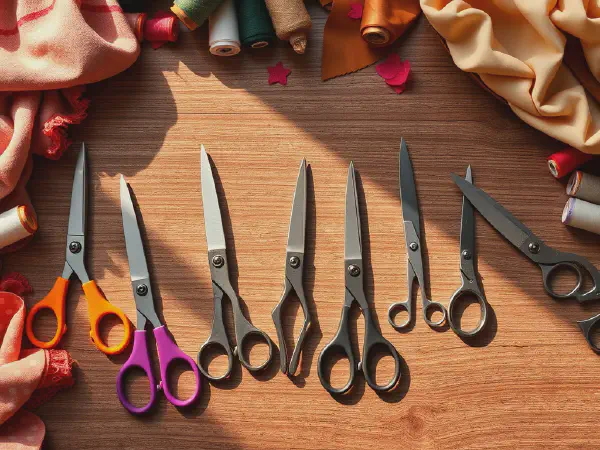Best Scissors For Cutting Fabric

The Ultimate Guide to Scissors: Everything You Need to Know
Scissors are a versatile tool that have been used for thousands of years. They are an essential item in any household or workspace and are used for a wide range of tasks, from cutting paper to fabric and even hair. In this comprehensive guide, we will explore the different types of scissors, important features to consider when buying scissors, top brands in the market, maintenance and care tips, and useful tips for cutting fabric.
First invented in ancient Egypt around 1500 BC, scissors have come a long way in terms of design and functionality. Today, they are available in various shapes and sizes, each with its own unique purpose. Whether you're a professional seamstress or simply need scissors for everyday tasks, understanding the different types of scissors can help you make an informed decision when purchasing.
When it comes to types of scissors, the options are vast. One of the most common types is the general purpose scissors. These are versatile scissors that can be used for a variety of tasks, such as cutting paper, opening packages, or even trimming small plants. They usually have stainless steel blades and comfortable handles for easy use.
For those involved in sewing and dressmaking, dressmaking scissors are a must-have. These scissors are specifically designed for cutting fabric and have long, sharp blades that allow for precise cutting. Some dressmaking scissors also have serrated blades, which help prevent fabric from fraying.
Another type of scissors that is commonly used in sewing and crafting is pinking shears. These scissors have a zigzag edge that creates a decorative pattern while cutting fabric. The zigzag edge helps prevent fraying and gives a professional finish to fabric edges. Pinking shears are particularly useful for sewing projects that involve woven fabrics.
Types of Scissors
In addition to general purpose scissors, dressmaking scissors, and pinking shears, there are several other types of scissors that cater to specific needs. Embroidery scissors, for example, have pointed tips and small blades, making them ideal for delicate embroidery work. Tailor's scissors, on the other hand, have long blades and are designed for cutting multiple layers of fabric with ease.
Features to Consider
Blade Material: The blade material plays a crucial role in the performance and durability of scissors. Stainless steel blades are commonly used as they are rust-resistant and maintain sharpness for longer periods. High-carbon stainless steel blades are even more durable.
Best Scissors For Cutting Fabric
Blade Length: The blade length determines the cutting capacity of scissors. For general purposes, a blade length of 6 to 8 inches is suitable, while longer blades of 10 to 12 inches are better for cutting fabric.
Handle Design: The handle design affects the comfort and control you have while using scissors. Look for ergonomic handles that fit comfortably in your hand and provide a secure grip.
Ergonomics: Consider the overall ergonomics of the scissors, including the weight, balance, and the angle between the handles and the blades. A well-designed pair of scissors can reduce hand fatigue and strain during extended use.
Cutting Performance: Pay attention to the cutting performance of scissors. Look for sharp blades that cut smoothly without tearing or snagging the material. Scissors with adjustable tension screws allow you to customize the cutting experience.
Top Brands
Fiskars: Fiskars is a renowned brand that offers a wide range of high-quality scissors for various purposes. They are known for their innovative designs and durable products.
Gingher: Gingher is a trusted name in the sewing and crafting community. They produce premium, precision-crafted scissors that are loved by professionals and hobbyists alike.
Kai: Kai is a Japanese brand that specializes in high-quality cutting tools. Their scissors are known for their sharpness and precision, making them a favorite among quilters and sewists.
Mundial: Mundial is a well-respected brand that has been producing scissors for over 80 years. They offer a wide range of scissors for various applications, including sewing, crafting, and industrial use.
Wiss: Wiss is a trusted brand that has been manufacturing scissors since 1848. They are known for their durable and reliable products, especially for industrial and professional use.
Maintenance and Care
To keep your scissors in top condition, regular cleaning is essential. Use a soft cloth or sponge with mild soap and warm water to remove any dirt or debris. Dry the scissors thoroughly after cleaning to prevent rust.
Sharpening scissors is another important aspect of maintenance. You can use a professional sharpening service or do it yourself with a sharpening stone or a specialized scissor sharpener. Follow the manufacturer's instructions for the best results.
When storing scissors, it's important to protect the blades to prevent damage. Consider using blade covers or storing them in a separate compartment or case. Avoid storing scissors in humid environments to prevent rusting.
To prevent rust, you can apply a thin layer of oil or lubricant to the blades. This helps create a barrier against moisture and oxidation. Remember to wipe off any excess oil before using the scissors.
Tips for Cutting Fabric
Choosing the right scissors is crucial when cutting fabric. Ensure you have sharp, dedicated fabric scissors that are suitable for the type of fabric you are working with. Avoid using fabric scissors for other materials to maintain their sharpness.
Before cutting fabric, it's important to prepare it properly. Make sure the fabric is clean and free from wrinkles by ironing it beforehand. This helps ensure accurate and neat cutting.
When cutting fabric, always use long, smooth strokes and let the scissors do the work. Avoid applying too much pressure or using a back-and-forth motion, as this can lead to jagged or uneven edges.
After cutting fabric, trim any loose threads and finish the edges as desired. You can use pinking shears for a decorative zigzag finish or use a serger or sewing machine to create a clean edge. Taking the time to trim and finish ensures a professional-looking result.
